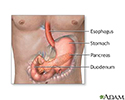Secretin stimulation test
Pancreatic function test
The secretin stimulation test measures the ability of the pancreas to respond to a hormone called secretin. The small intestine produces secretin when partially digested food from the stomach moves into the area.
How the Test is Performed
The health care provider inserts a tube through your nose and into your stomach. The tube is then moved into the first part of the small intestine (duodenum). You are given secretin through a vein (intravenously). The fluids released from the pancreas into the duodenum are removed through the tube over the next 1 to 2 hours.
Sometimes, the fluid can be collected during an endoscopy.
How to Prepare for the Test
You will be asked to not eat or drink anything, including water, for 12 hours before the test.
How the Test will Feel
You may have a gagging feeling as the tube is inserted.
Why the Test is Performed
Secretin causes the pancreas to release a fluid that contains digestive enzymes. These enzymes break down food and help the body absorb nutrients.
The secretin stimulation test is done to check the digestive function of the pancreas. The following diseases may prevent the pancreas from working properly:
- Chronic pancreatitis
- Cystic fibrosis
- Pancreatic cancer
In these conditions, there may be a lack of digestive enzymes or other chemicals in the fluid that comes from the pancreas. This can reduce the body's ability to digest food and absorb nutrients.
Normal Results
Normal value ranges may vary slightly depending on the lab doing the test. Talk to your provider about the meaning of your specific test results.
What Abnormal Results Mean
Abnormal values may mean that the pancreas is not working properly.
Risks
There is a slight risk of the tube being placed through the windpipe and into the lungs, instead of through the esophagus and into the stomach.
References
Pandol SJ. Pancreatic secretion. In: Feldman M, Friedman LS, Brandt LJ, eds. Sleisenger and Fordtran's Gastrointestinal and Liver Disease. 11th ed. Philadelphia, PA: Elsevier; 2021:chap 56.
Semrad CE. Approach to the patient with diarrhea and malabsorption. In: Goldman L, Schafer AI, eds. Goldman-Cecil Medicine. 26th ed. Philadelphia, PA: Elsevier; 2020:chap 131.
Siddiqi HA, Rabinowitz S, Axiotis CA. Laboratory diagnosis of gastrointestinal and pancreatic disorders. In: McPherson RA, Pincus MR, eds. Henry's Clinical Diagnosis and Management by Laboratory Methods. 24th ed. Philadelphia, PA: Elsevier; 2022:chap 23.
Review Date: 11/3/2022
Reviewed By: Michael M. Phillips, MD, Emeritus Professor of Medicine, The George Washington University School of Medicine, Washington, DC. Also reviewed by David C. Dugdale, MD, Medical Director, Brenda Conaway, Editorial Director, and the A.D.A.M. Editorial team.





